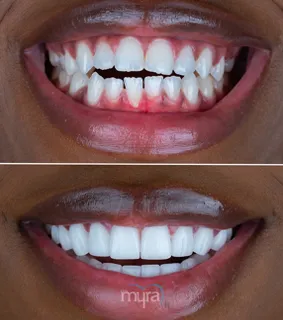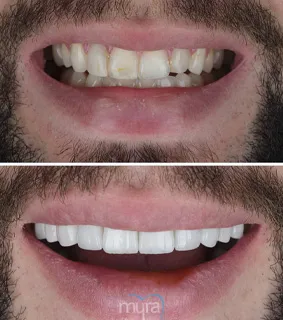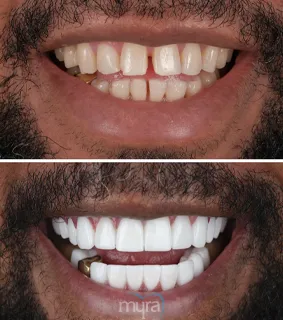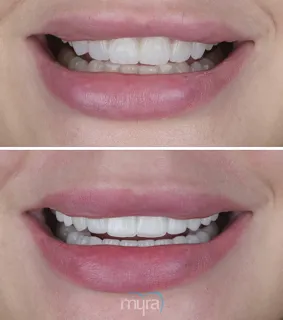Teeth whitening is the treatment used to lighten the appearance of a person’s teeth. There are a lot of ways to perform teeth whitening. The most utilised techniques are through a manual removal of the teeth stain and through a biochemical reaction from an applied chemical substance in the teeth. Some of the types of teeth whitening techniques include toothpaste, whitening strips, pre-made whitening trays, custom-made whitening trays and in-office whitening which are going to be discussed below. The average payment for teeth whitening ranges from £211.23 – £422.46 with respect to the technique employed to the teeth. Teeth whitening is expected to bring soreness to the patients and promulgate unpleasant reactions after the procedure. The length of the recuperation period for most teeth whitening techniques usually lasts for a few days after the treatment but is subject to change depending on the type of the technique used and the expertise of the licensed dentist. Dental patients are encouraged to seek a thorough recommendation from a licensed professional who is certified by an accredited body. The outcome of Teeth whitening is expected to last up to three years, although it does not permanently whiten teeth. The duration of these effects depends on the type of teeth whitening technique employed and the oral routine of the patient. Most clients who plan to go through teeth whitening wonder if it is proven safe. The answer to that inquiry is yes.Teeth whitening is harmless. Aftereffects are expected to arise but they are generally bearable. There are dental professionals to perform the in-office whitening operations who follow a set of precautionary measures during the entire process making teeth whitening a secure method. One must religiously follow the guidelines set by the licensed professional to achieve greater results. However, even with strict obedience to proper oral routines teeth whitening remains not a temporary remedy to teeth staining.
What is Teeth Whitening?
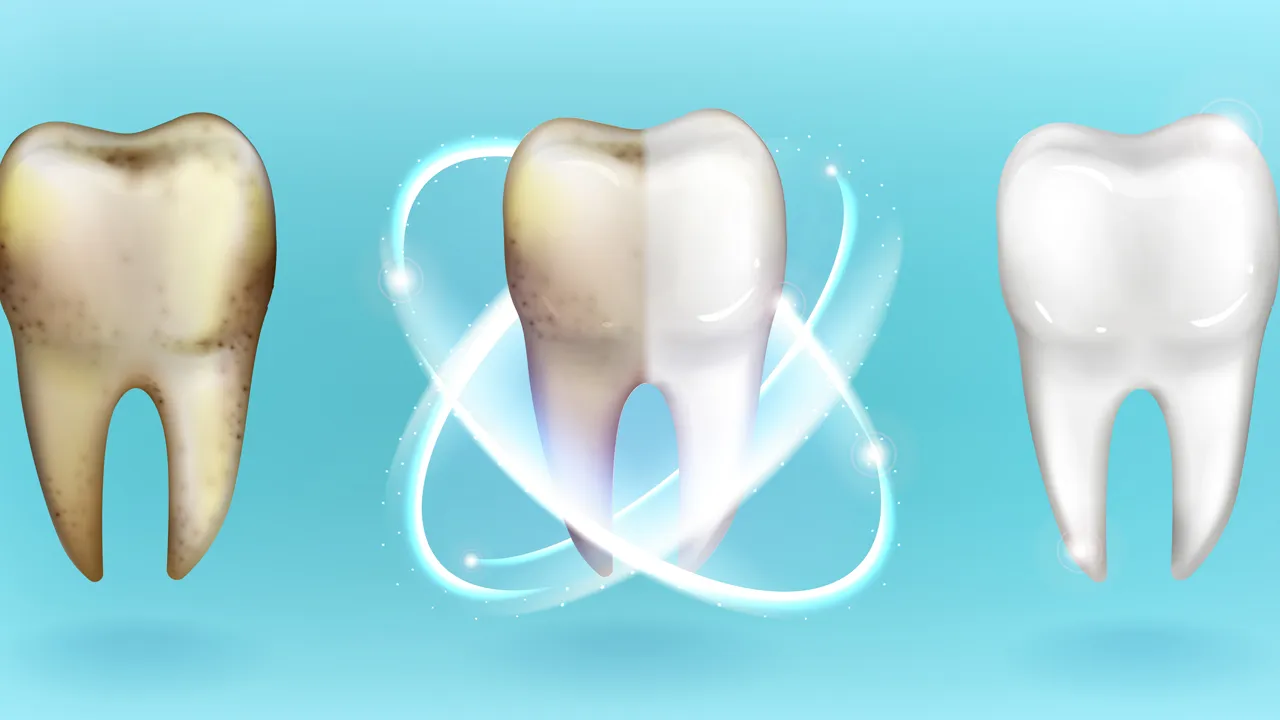
Teeth whitening is a dental process known to successfully lighten the colour of the teeth. Standard teeth whitening techniques are not capable of creating a holistic change of colour in the teeth. However, more and more advanced procedures have been developed in teeth whitening these days to achieve better and long lasting results. Teeth whitening is proven effective to brighten one's teeth. There are different techniques for teeth whitening that a person is able to utilise. Some are allowed to be done at home, while some require professional intervention. Teeth whitening techniques include applying a whitening toothpaste, using whitening strips and whitening trays, or going through an in-office whitening procedure. There are a lot of good reasons why a person must experience teeth whitening. The first on the list is having different types of teeth from others. Human teeth vary from one another just like the hair and skin. There are people who are gifted with radiant white teeth. There are some who are not. Another reason is the colour development of human teeth. A person’s teeth get discoloured as he or she gets older. One of the contributors of teeth discoloration is a person’s food and beverage consumption over the years. Foods and drinks contain substances that are capable of staining the teeth after continued consumption. Oral vices like smoking are one of the reasons why the teeth get stained as well. Regular smoking is capable of building up tartar or calculus in the teeth which are difficult to remove just by brushing. These are the factors that make teeth whitening a very important activity which needs to be included in one's lifestyle. The purpose of teeth whitening is to make a person’s teeth look brighter and whiter. Whiter and brighter teeth produce a lot of benefits into a person’s life. Studies show that a person’s appearance gets more attractive with whiter teeth. It enhances how a person looks in front of other people thus changing how they relate with one another. Having whiter teeth is oftentimes perceived as a factor to boost one's self-esteem and confidence as well. It is actually the reason why most people go through teeth whitening. It is believed that a person’s smile is one of the things that gets noticed around people, that is why teeth whitening is in-demand these days. Teeth whitening is capable of reducing the appearance of wrinkles as well. It creates a diversion for people to notice someone’s wrinkles.People are expected to focus on the white smile instead. Lastly, having a whiter teeth through teeth whitening is affordable. It is a lot cheaper than plastic surgery. Teeth whitening is best paired with a regular application of an enhancer at home. These two are already capable of bringing out good results at an economical price. Teeth whitening methods that are suitable to one’s budget and personal preference are available nowadays. A teeth whitening treatment is either done at home or at a dental facility depending on the type of method preferred by the patient. Nevertheless, dental patients are advised to see a professional dentist personally, to ensure an effective, safe and quality teeth whitening results.
When is Teeth Whitening needed?
Teeth whitening is needed to be applied on one’s teeth when they reach the point of discoloration.
Teeth discoloration or teeth staining happens when the natural colour of the teeth changes. It is usually categorised into three namely, mild, moderate , and severe. Severe staining is one of the reasons why dentists advise immediate teeth whitening. Some cases of severe discoloration came from years of stain build up making it difficult to remove, it makes the natural colour of the teeth uneasy to restore as well. The patient is required to go through a series of whitening sessions when the stain is severely attached to the teeth. Mild to moderate staining involves teeth stains that are caught on the early stage of discoloration. It often takes a session or two to remove these types of stains. At home teeth whitening treatment from a professional dentist is applicable for mild and moderate staining. Mild and moderate discoloration normally come from a few months of stain build up. Professional dentists always advise patients on going through teeth whitening during the early stage of discoloration to avoid getting it worse. Mild and moderate stains are much easier to treat with less volume of chemicals used. Discoloured teeth are often caused by a number of factors grouped into three namely extrinsic, intrinsic, and age-related. Some of these factors include improper oral hygiene, having medication, food and beverages consumption that stain the teeth. Improper oral hygiene is one of the main reasons why a person’s teeth experience discoloration. It usually includes inconsistent brushing and flossing of the teeth. Chemical substances from every meal most likely stick to the enamel of the teeth. These substances build up in the teeth over time and form stains, without consistent and proper brushing and flossing habits. Taking harmful substances into the body through the mouth like smoking cigarettes or tobacco is considered an example of improper oral hygiene as well. Smoking cigarettes or tobacco actually falls under the extrinsic type of staining. These types of stains solely affect the outer layer of the teeth or the enamel. Cigarettes or tobacco contain nicotine that sticks to the teeth’s enamel forming tartar or calculus over time. Oral medications are another cause of teeth discoloration. They are a type of staining that belongs to the intrinsic group. Intrinsic types of stains occur inside the tooth. These types of stains are more difficult to remove and require intensive whitening strategies. Medications contain substances that are able to stick to the tooth creating a greyish formation beyond the enamel of the teeth. Food and beverages are the most common reason for teeth discoloration. These types of stains fall under the extrinsic group. Drinks such as red wine, coffee, tea, and blackcurrant are examples of stain producing beverages. Age is capable of producing discoloured teeth as well. As people get older, the enamel on their teeth starts to change into a yellowish appearance indicating weakness and vulnerability. However, aside from teeth discoloration, another situation where teeth cleaning is necessary is prior to dental procedures. The reason for that is, artificial teeth or crowns are not suitable for teeth whitening treatments. The artificial teeth’s colour or appearance are based on the remaining natural teeth. There is a possibility that the colour of the teeth, both natural and artificial, is going to be different when teeth staining occurs. Most professional dentists advise patients to undergo teeth whitening first before installing any dental devices or dental implants so that the natural teeth and the artificial teeth’s colour match.
What are the types of Teeth Whitening?

Listed below are the following types of teeth Whitening.
- Whitening Toothpastes. Whitening toothpastes are specially formulated toothpastes to brighten the teeth. It is a teeth whitening product that is purchasable over-the-counter or OTC. Whitening toothpastes are suitable for teeth blemishes that are superficial, affecting the topmost coating of the teeth. They are applied to the teeth just like regular toothpaste, at least twice everyday. However, it contains a substance called Blue Covarine to specifically illuminate the teeth’s natural white colour. The effect of whitening toothpastes are visible after two to six weeks of pursued application.
- Whitening Strips. Whitening Strips is another teeth whitening merchandise that is way cheaper and easier to use compared to other solutions. It is made up of an elastic narrow piece of Polyethylene which contains Hydrogen peroxide that cleanses the teeth. Whitening strips are placed over the teeth bed and left for thirty minutes. Dentists encourage dental clients and patients to perform two applications of whitening strips everyday for two consecutive weeks to get good results. However, the whitening efficacy of whitening strips is a little bit poorer than whitening toothpastes or other teeth whitening treatments.
- Premade Whitening Trays. Premade Whitening Trays are dental apparatus that resemble the appearance of sport mouthguards which help in eliminating superficial blemishes in the teeth while making the teeth look brighter. It is a type of teeth whitening tray that has a design and structure that are fit for almost all dental product consumers. Premade Whitening Trays are purchasable over the counter. Premade whitening trays are easily accessible and offer immediate whitening outcomes. However, the whitening effect of premade whitening trays is not permanent.
- Custom Made Whitening Trays. Custom made whitening trays are a type of whitening trays which are personalised or built according to the patient’s specific dental structure. Custom made whitening trays are preferred over premade whitening trays because they are more stable. They provide a good fit to the teeth’s full arch as well. Custom made whitening trays are advised to be placed on the teeth for about four hours, everyday in two consecutive weeks. Sensitivity is still expected to occur during the utilisation of custom made whitening trays just like most types of teeth whitening methods.
- In-office Whitening. The In-Office whitening method is another type of teeth whitening technique that is performed within a dental facility and is executed by a professional dentist. In-Office whitening technique produces immediate whitening results without having to compromise safety and efficiency. The process often takes an hour or less. Dental patients are expected to acquire brighter teeth in almost 8 shades after the process. Most dental patients find satisfaction in In-Office Whitening than any other teeth whitening methods.
1. Whitening Toothpaste
Toothpaste is a concentrated sticky gel or paste containing compounded elements paired with a toothbrush to sanitate and maintain the cleanliness of the entire mouth including the gums, tongue, inner cheeks and especially the teeth. Standard toothpastes do not contain whitening ingredients. Some are manufactured with a little whitening power but most toothpastes contain fluoride to provide stronger teeth and to kill bacterias in the mouth. However, there are specialised toothpastes which are formulated to specifically radiate the whiteness of the teeth. These are called whitening toothpastes. Whitening toothpastes usually contain Peroxide which softens, breaks, and dissolves the stains in the enamel layer. It holds another chemical named Blue Covarine to fabricate an optical illusion making the teeth appear whiter. Whitening toothpastes have special abrasives as well which acts as a gentle polisher of the teeth. Whitening Toothpastes are suited for extrinsic types of stains. Extrinsic stains are teeth discolorations that have been noticed building up during the early weeks of teeth staining. These stains are usually superficial but are able to worsen if taken for granted. Whitening toothpastes are known to remove extrinsic stains from the enamel of the outer covering of the teeth. It is used to prevent extrinsic stains from coming back as well provided that it is regularly used.
However, whitening toothpastes are not capable of removing stains that go beyond the enamel layer of the teeth. Intrinsic stains or discoloration inside the teeth are removed with the application of more intensive techniques. The procedure of applying whitening toothpastes is not different from applying regular ones. The consistency however must be done two times a day to ensure good results. The effect of whitening toothpastes is noticeable within two to six weeks of use.The presence of Blue Covarine allows the teeth to gain immediate change in their colour, appearing whiter and healthier. Dental patients however, are encouraged to observe manufacturer procedures when using whitening toothpastes. An excess is always harmful, even when it comes to whitening toothpastes. Dental patients are advised to choose a toothpaste brand that holds a seal of approval from reliable dental associations indicating that the toothpastes is safe to use and effective in dissolving extrinsic stains at the same time.
2. Whitening Strips
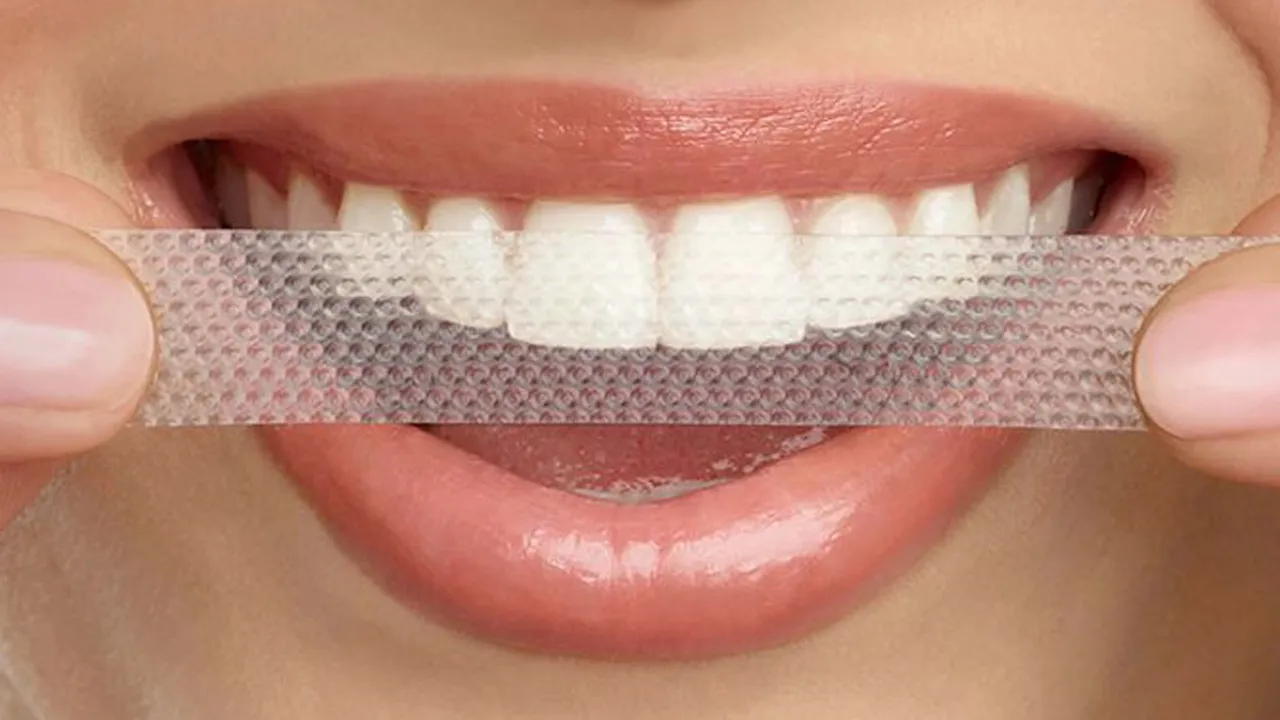
Whitening Strips are dental products known to dissolve tooth stain and help whiten teeth in an easier and cheaper way. It is a type of teeth whitening approach that is made available over the counter or OTC which makes it an immediate solution for teeth stain removal and teeth whitening. Whitening strips are appropriate for the elimination of extrinsic stains which are accumulated from food and beverage intake, tobacco smoking or poor oral hygiene just like whitening toothpaste. The distinction that they hold is that whitening strips have an immediate whitening outcome compared to whitening toothpastes. Whitening strips are usually characterised by a white, narrow piece of polyethylene containing a substance called Carbamide Peroxide or Hydrogen Peroxide. Hydrogen peroxide or commonly known as bleach is the substance responsible for clearing the stain out of a person’s teeth. It works the same way as it cleanses stains from the clothes or from a person’s hair. The steps in utilising Whitening strips start by laying down the strip directly into the teeth bed. Most whitening strips must be stuck to the teeth bed for about thirty minutes allowing the chemicals to work. They are allowed to be removed after the specified duration. Brushing the teeth a few minutes before using the whitening strips is discouraged. Whitening strips must be employed to the teeth two times a day for two consecutive weeks to attain desired results.The efficacy of whitening strips however, are not parallel to efficacy of teeth whitening treatments done in a dental facility. The reason behind it is that whitening strips have smaller doses of whitening stimulants compared to whitening solutions available in a dental facility. Dental clients with severe teeth blemish are discouraged to use over -the-counter teeth whitening merchandise like whitening strips, as they are going to obtain the outcome that they desire. Moreover, the efficiency of whitening strips depends on the dosage of whitening agents that they contain. Some Whitening Strips depend on the length of the time duration when it is placed in the teeth before the result gets evident. There are noted disadvantages for whitening strips as well, just like other types of teeth whitening. Some of the side effects that dental patients are expected to experience in using whitening strips are as follows, tooth sensitivity, gum irritation and deteriorated teeth from overuse.Dental clients or patients are encouraged to consider certain criteria in choosing the right whitening strip to utilise such as the mixtures used, the dentist's approval and the customer reviews. It is ultimately advised that dental clients seek a professional recommendation before utilising whitening strips.
3. Pre-Made Whitening Trays
Another type of teeth whitening products are the Whitening Trays. Whitening trays look like a sport mouthguard that is put on the full arch of the upper and lower teeth. A whitening gel is incorporated inside the whitening tray. The whitening gel is the one responsible to perform the cleaning and whitening job while it is still attached to the full arch. There are two types of whitening trays available to choose from. One of which are the Premade Whitening Trays. Premade whitening trays, from the name itself, is a type of whitening tray whose design is derived from a standard model. Its size, form and structure is fashioned for universal usage. These types of trays are purchasable on drug stores since they are made available on an OTC or over the counter basis. Premade whitening trays are allowed to be performed at home because they do not require a procedure or pre moulding session with a dentist. Premade whitening trays are usually made up of a stretchable material that fits into the teeth’s full arch. The tray is filled with a peroxide content in the form of a gel which is responsible for the removal of teeth stain and reveals the teeth’s natural white colour. There are disadvantages that Premade Whitening Trays hold. One of these disadvantages include the fit of the whitening tray to the teeth’s full arch. Premade whitening trays have less stable fit leading to uneven whitening, irritation and sensitivity. They have a decreased amount of bleaching contents as well. Over the counter products like premade whitening trays are filled with lower concentrations of peroxide to avoid unwanted complications and harmful side effects to the consumers. One of the disadvantages of over-the-counter whitening products such as premade whitening trays is that they are inconvenient to use. They have a tendency to slip from the teeth arch since they are not designed according to the patient’s specific teeth structure. Another disadvantage is that they do not whiten the entire teeth set effectively. Most OTC whitening products are capable of brightening the front teeth but not those at the back portion of the teeth.
4. Custom-Made Whitening Trays
Custom made whitening Trays is a type of whitening tray that is created according to the patient’s dental structure. These trays hold a resemblance of a sport mouthguard, which is incorporated with a whitening gel inside of it to remove the teeth stain and whiten the teeth. Custom Made Whitening Trays are installed inside a dental facility performed by a professional dentist unlike whitening strips or toothpastes. The process of applying a custom made whitening tray starts with a consultation with a dentist. The dentist creates a moulded design for the patient’s custom whitening tray. Once the whitening tray is created the whitening tray is placed on the full arch of the upper and lower teeth everyday for about 4 hours in 2 consecutive weeks. The whitening effects of whitening trays are visible after the specified time duration. Custom Made Whitening Trays are chosen by dental patients over premade whitening trays because they provide a good fit to the full arch and produce comfort while usage. They provide a tight and stable fit making them more effective than premade whitening trays. Another advantage that Custom made Whitening Trays hold is that they produce lesser gum irritation. The exact fit that it provides prohibits friction in the gum line and the teeth resulting in lesser pain and discomfort. However, the anticipated cons of Custom made whitening Trays are still expected to occur. One of which is sensitivity. Sensitivity to frozen food products is anticipated to arise because of the peroxide content of the whitening gel inside the tray. However the sensitivity is expected to ease after a few days. One of the disadvantages of Custom made whitening trays is that they require enough time in moulding the replica of the patient’s teeth structure. Another thing is that dental patients who started a custom made whitening tray method are encouraged to have a subsequent check-up with their dentist to monitor the progress of the teeth and assess scenarios of damage or irritation.
5. In-Office Whitening
The In-Office Teeth Whitening is a type of whitening method that is performed and closely monitored in a dental or clinical facility. Most people call it Chairside bleaching because it is done while the patient leans back on a chair bed. In-office teeth whitening or Chairside bleaching is an effective way of achieving whiter teeth. It is generally executed with utmost caution and regular monitoring since it is personally performed by a professional dentist and takes place inside a dental office. It is proven safer to go through an in-office whitening operation than use OTC products since the application of the whitening substances is being controlled by the dentist. Moreover, In-office whitening approach produces prompt visible results without compromising safety. The procedure for in-office whitening method starts with a consultation from a licensed dentist. Once the pros and cons are discussed and approved by the patient, the physical procedure begins. A dental device called cheek retractor is placed on the patients’ mouth as they lay on the chairside. The cheek retractor helps the dentist to make all the teeth from the upper and lower jaws become visible. A hardening wax is applied before the whitening substance is painted on the teeth. A hardening wax which dentists refer to as a liquid rubber dam is coated into the gum tissue to serve as a protective barrier against gum irritation brought by the peroxide content of the whitening gel. Once it is set, the whitening gel is applied to the teeth. It must remain on the teeth for a number of minutes. Some dentists incorporate the use of intense light while the whitening gel is still soaked on the teeth to expedite the whitening interaction. The bleaching gel is removed from the mouth by a suction after a specific duration set by the dentist. A fresh gel is painted to the teeth after all the bleaching gel is removed from the mouth and stays there for about fifteen to thirty minutes. The same cycle is repeated once the desired whiteness is not yet achieved. However, in between the gel application, the dentists religiously check if the colour of the teeth have improved. Once the desired appearance of the teeth is attained, the dentist removes the cheek retractor and rinses the patient’s mouth. A shade change measurement is conducted to see the improvement of the teeths colour after the operation. The outcome of the in-office teeth whitening method appears visible right after the operation. Most patients achieve whitened teeth up to two to eight shades already. However, dentists suggest a follow-up whitening schedule if the results seemed discouraging. Some dentists provide their patients with a set of bleaching trays which they are able to use at home to improve the appearance of the teeth. One of the precautions under in-office whitening is that the outcome it produces is not stable. The outturns rely on the patient’s age, heredity and the type of teeth stain existing on the teeth. Another disadvantage of in-office whitening is that it requires a follow-up session. The teeth start to generate stains again a few days after the whitening process especially when the treatment is not properly executed. It is expected to cost much in the long run after taking a number of sessions.
What are the benefits of Teeth Whitening?
Teeth Whitening comes in different approaches. It is either done personally at home or with the help of a licensed professional. However, the Professional Teeth whitening approach is believed to provide better and long lasting whitening results compared to at home or personal whitening techniques.
Listed below are the benefits of Teeth Whitening from a professional dentist.
- Thorough whitening. A professional teeth whitening approach produces a holistic whitening result. The teeth are cleaned from all sides in a professional teeth whitening method which thoroughly removes the superficial teeth stains and reveals the natural white colour of the teeth. Intensive cleaning is indeed guaranteed in a professional teeth whitening approach because it is personally performed by a dentist. Discoloration from hard to reach teeth is properly handled by a professional dentist which over the counter whitening products are not able to do.
- Reliable Treatment. Teeth whitening performed under the expertise of a professional dentist is expected to bring out a positive outcome. Whitening techniques that are done without the aid of a dental expert is often dangerous and unreliable. Professional teeth whitening includes a preliminary consultation between the licensed dentist and the patient creating a good start in the whitening procedure. The patient’s teeth structure is properly assessed by the dentist including his or her dental background and current health conditions during the consultation. The dentist suggests what treatment must be done for the patient. The right amount of whitening substance that is suitable for the patient’s teeth is determined during the consultation at the same time. The dental patient is deemed safe from overdosage and from the harmful side effects of excessive bleaching. Knowing the specific dental information of the patients allows the dentist to make the right decisions for them.That is the main reason why professional teeth whitening approach is reliable.
- A boost in confidence. Teeth whitening absolutely increases a person’s level of self-confidence. Having clean and white teeth brings a feel-good sensation. When a person feels good about themselves, confidence just follows. Most patients who have discoloration often hide their teeth from the public which limits their way of living and socialisation. However, a lot of teeth whitening methods have alleviated the dilemma of teeth discoloration the moment they were discovered. Dental patients are relieved from having to feel conscious in their heads about the appearance of their teeth allowing them to look great on the outside. People are encouraged to make use of the different teeth whitening methods accessible nowadays to be free from the burden of teeth discoloration.
- Quicker results. The results from a professional teeth whitening is far more speedy and high quality at the same time compared to at home whitening techniques. Most professional whitening techniques are able to produce whitening effects in just a few hours. Dental patients don't have to wait for weeks or months to get reliable results from teeth whitening methods. Over the counter whitening products are able to give immediate results but do not assure long lasting quality. Professional teeth whitening methods offer an assurance of a satisfactory teeth whitening result.
- Enhance appearance. Teeth whitening methods have helped a lot of individuals in achieving a more improved facade. Having whiter teeth allows a person to look younger than his or her actual age. It actually reduces the appearance of facial wrinkles by creating a diversion. They say a person’s smile is the first thing that people notice in an individual. A person is able to appear with a more pleasing facade with cleaner and brighter teeth because of teeth whitening. An enhanced appearance brings more wonderful opportunities as well. People with whiter teeth become more noticeable and hard to forget compared to those who don't. It further creates an essential effect to a person’s existence. These are some of the wonderful Benefits of Teeth Whitening to every dental client.
What are the risks of Teeth Whitening?
Listed below are the risks of Teeth Whitening.
- Tooth Sensitivity. Tooth sensitivity is a condition where the tooth gets very quick to respond to minimal movements or signals in the mouth. It is one of the common risks of teeth whitening methods. Tooth sensitivity normally starts to take place during the teeth whitening session which is often experienced up to several days after the treatment. Tooth sensitivity is often characterised with a short tingling pain. It happens when the enamel coating of the tooth gets thinner and aggravates the dental nerves beneath it. The Peroxide content of whitening substances is capable of scraping the teeth to remove teeth stain. However, when it is abused the chemical is able to cause excessive damage to the enamel. The sensitivity of the teeth is often experienced when eating hot and cold foods or drinks. Tooth sensitivity is expected to occur whether from personal or at home whitening treatment or from professional whitening schemes. Some dental consumers prefer using at home teeth whitening kits but in-office whitening methods are way safer and provide longer lasting whitening effects. Patients who are already aware of their tooth sensitivity are advised to prefer the professional in-office whitening method , as it is closely monitored by dentists. A professional dentist is able to recommend immediate sensitivity solutions and be able to control its severity.
- Gingival Irritation. Gingival irritation is another condition that is expected to rise up when going through a teeth whitening procedure. It is characterised by an inflammation of the gingiva or the gums located around the tooth as a response to an irritant substance. Gingival irritation is often caused by the overuse of peroxide content in the whitening substance. One of the whitening products that pose a possibility of over usage are those available over the counter such as premade whitening trays and whitening strips. People who utilise OTC whitening products are not governed by the application guidelines set by professional dentists. They have the freedom to either follow the instructions from the product or use excessive amounts according to their preference. These people are most likely to experience gingival irritation and tooth sensitivity. Dental patients who have no history of tooth sensitivity of gum irritation are allowed to use OTC whitening products. However, they are encouraged to seek professional advice once irritation takes place.
- Tooth Damage. Tooth damage or tooth erosion is another noted risk of teeth whitening. It imposes a harmful effect in a patient’s dental health, although it is not as popular as tooth sensitivity and gum irritation. Tooth damage is a phenomenon when the tooth gets deteriorated due to the loss of dental tissue and minerals in the teeth. The loss of these dental minerals are caused by harmful chemicals used in the mouth. Whitening substances are capable of damaging the tooth when used inappropriately and without proper control. There are instances where bleaching agents fall into tooth cracks or unfilled cavities which are absorbed by the tooth causing internal damage.
- Over whitening. Over whitening is a risk that is expected to occur in a teeth whitening treatment. Over Whitening is the excessive use of whitening substances in order to achieve whiter teeth in an immediate way. It is a risk usually encountered by dental clients who utilise home-based whitening treatments or over the counter whitening products. The effects of over whitening is actually opposite to what consumers desire to have. Over whitening of the teeth leads to translucency. The colour of the teeth becomes yellowish instead of white. Some teeth are turned to blue oy grey due to over whitening. Over Whitening is avoided by seeking professional advice from licensed dentists.
- Burns and Blisters. Burns and blisters are unusual cases for teeth whitening. However, it is still anticipated to occur when overuse or misuse of whitening agents is practised. Dental patients experience burns and blisters when the whitening substance remains soaked in the teeth longer than advised. The heat produced during the chemical reaction of the whitening substances causes the burning sensation in the mouth thus, generating burns and blisters inside. There are instances where whitening gels are not applied properly causing burns and blisters in the mouth as well. People who obtain burns and blisters right after the teeth whitening treatment must wash their mouth with cold water and cover them with topical numbing cream. An appointment with a licensed dentist is needed once the pain continues.
- Allergic Reaction. Another noted recorded risk of teeth whitening is Allergic Reaction. Allergic reaction is a phenomenon where a person’s body reacts to a certain substance that appears harmless to most people. Allergic reaction is often characterised by itching, inflammation, and skin injury. There are dental patients who hold an unusual response to whitening agents. Dental patients who are suffering from allergic reactions usually show signs of hives which is an itchy rash in the skin, difficulty in breathing, and swelling of the face, lips and tongue. These allergic reactions often take place from a whitening treatment done at home. Dental patients are encouraged to visit a professional dentist once these situations rise.
- Upset Stomach. Upset stomach or stomach ache is a painful discomfort experienced in the abdominal area normally caused by inflammation in the stomach lining and intestines. It is one of the uncommon risks of teeth whitening but still impose harmful effects to the patient’s health. Upset stomach occurs when the patient or dental consumer accidentally swallows some portions of the whitening agent used in the whitening treatment. The common symptoms of an upset stomach include abdominal cramping, vomiting, diarrhoea, headache, fatigue, and chills. People who encounter an upset stomach during the whitening procedure are advised to take lots of beverages and eat bland to flush out the swallowed chemical out from the stomach and ultimately out from the body. It is to avoid serious complications of the whitening agent to the patients’ body.
- Rough Teeth. Rough teeth are another example of infamous risks under teeth whitening. However, for the same reason with burns and blisters, allergic reactions, and upset stomach, rough teeth are capable of causing further damage when not dealt with at the earliest opportunity. Rough teeth happen when the bleaching agent is left in the teeth for a longer period of time than what is advised. They often result in discomfort in the mouth , particularly in speaking, eating and drinking. Rough teeth are caused by an etching action between the enamel of the teeth and the hydrogen peroxide in the whitening substance. The teeth are said to mineralize again within 24-48 hours after the treatment. Dental patients are prohibited to intake anything that has colour during that period because the teeth are more vulnerable to staining.
What are the procedures of Teeth Whitening?
The procedure of Teeth Whitening depends on the type of whitening method used. Teeth whitening is either performed personally at home or at a dental facility with a dentist’s close supervision. The latter is commonly referred to as Professional Teeth whitening which follows a standard procedure in executing the whitening treatment.
The procedure for Professional Teeth whitening is listed below.
- Checking the shades. The first step to Professional Teeth Whitening is done by checking the current shade of the patient’s teeth. It is to have an exact understanding of the level of teeth discoloration obtained by the patient. It is a dentist’s way of knowing how much whitening solution is necessary to come up with the desired results. Most dental facilities make use of a shade guide and take photographs of the patient’s teeth appearance during the first step.
- Cleaning and polishing. The next step to teeth whitening is the Cleaning and Polishing. The patient’s teeth are being sanitised and smoothen during the second step. Professional dentists utilise a powder based substance called pumice to clean and polish the teeth. It removes some of the seated plaque and tartar build up in the teeth to allow a more effective whitening process. Pumices work best on a dry platform which is why most dentists are observed to place a gauze pad on the patient's mouth. The pumice is removed from the mouth through rinsing and suctioning. A cheek retractor is placed in the mouth after the teeth are being cleaned and polished. Cheek retractor is a helpful tool to make all the teeth visible to the dentist’s view. It prevents the tongue, lips and gums from touching the whitening sentence as well.
- Applying with a Gingival barrier. The Gingival barrier protects the gingiva or the gum around the teeth from being exposed to the whitening agent. It looks like a paste that is painted on the gum curves along the tooth neck of the upper and lower teeth. Some dentists make use of cotton balls beneath the upper and lower lips to provide more isolation for the teeth. A specialised curing light is utilised in some dental facilities to stabilise and solidify the gingival barrier on each tooth in place. It is usually set on a fanning motion for about ten to twenty seconds to guarantee firm hold. However, before the gingival barrier is applied the teeth need to be dried up.
- Coating with a whitening agent. The whitening agent is applied on the teeth once the gingival barrier is dried up. Whitening agents normally contain a Hydrogen peroxide solution which is responsible for scraping deep seated stains and changing the colour of the teeth. The anterior factions of the upper and lower teeth are the parts which are normally coated with the whitening solution using a dental brush while the rear side of the teeth are left untouched. The whitening agents are capable of opening the tiny pores on each tooth where the tooth stains are seated. The whitening agents perform an intensive cleaning deep within the coating layer of the teeth. The teeth remain coated with the bleaching agent for about thirty minutes. Most dental facilities employ dental whitening lights to expedite and enhance the work of whitening solutions in the teeth. The whitening solution is removed from the teeth using some gauze and cotton rolls after the specified time duration. The coating of whitening agents is repeated a number of times until the colour of the teeth improves. Most dental facilities redo the coating step for up to three to four times before the desired result is attained. Professional dentists take a pause every time the coating is removed to assess and record the improvement of the teeth’s appearance.
- Rinsing. The entire mouth is rinsed meticulously once the appearance of the teeth is already in line with the desired colour of the patient and the dentist. There must not be a residue of the whitening chemicals left in the mouth as they are capable of further health issues. Some dentists use suction to thoroughly remove the whitening solution from the mouth. The cotton rolls, gauze, gingival barrier are later removed from the mouth. The dentist usually brushes the patient’s teeth afterwards, while the cheek retractor is still placed in the mouth. Brushing the teeth in the teeth whitening treatment is an indication that the teeth are being prepared for the last step of the procedure which is the fluoride treatment.
- Applying the fluoride treatment. The fluoride treatment is applied to the teeth to sustain the brightness and the radiance of the newly treated teeth. Fluoride is utilised to sweep off any underlying plaque left in the mouth as well. Most dental facilities record the final outcome of the whitening treatment for each patient. Some dentists take photos of the newly treated teeth for records purposes and future usage.
The process discussed above comprises the standard Steps of Teeth Whitening treatments. However, it is essential to emphasise that before any professional teeth whitening procedure takes place, the dentist needs to assess the patient’s dental structure, shade and pertinent history to be able to come up with effective, safe and desired results.
How Much Does a Teeth Whitening Cost?
The cost of Teeth Whitening differs depending on the type of whitening method employed in the patient. The cost of over-the-counter whitening merchandise which are allowed to be applied to the teeth at home without the dentist's supervision ranges from £16.45 to £82.25. Some of these at-home whitening merchandises include Whitening toothpastes, Whitening strips, and Premade Whitening Trays. In-Office whitening techniques on the other hand, are expected to cost higher than over-the counter whitening merchandises. The pricing of In-Office whitening operations scale between £211.23 to £422.46 depending on some elements that affect the overall cost of the process. The average cost for In-Office Whitening surgery amounts to £334.60 per session. There are factors that affect the cost of Teeth Whitening Process. Some of these factors include the kind of whitening technique employed and the number of whitening sessions performed, the severity of tooth staining, and the proficiency of the dentist. The price of the whitening process additionally depends on the area where the treatment is performed, the supplemental processes done before the whitening process, and the number of follow up visits after the whitening treatment.
The kind of whitening treatment applied and the number of sessions performed throughout the whitening process affects the gross costing of teeth whitening. There are teeth whitening techniques that have lower cost than others just like whitening strips, whitening toothpastes, and other over-the-counter whitening products. Over-the-counter whitening merchandises don’t require professional supervision as well, which eliminates the cost for the professional fee. On the other hand, licensed whitening operations such as In-Office whitening are expected to be costly. They often involve the use of dental materials during the treatment such as cheek retractor, curing light, gingival barrier and pumice that contribute to the total cost of the procedure. A professional fee is included in the costing as well, since it is the dentist who executes the procedure personally. The number of sessions performed throughout the procedure contributes to the costing of teeth whitening too. Most licensed whitening techniques require subsequent meetings before the procedure is accomplished. OTC whitening products demand several applications as well to attain genuine results. The more sessions performed and more applications required, the higher the cost gets. The severity of tooth discoloration is another contributing factor to the costing of teeth whitening. Teeth having severe stains are the ones which usually require numerous treatment sessions and higher rates of bleaching concentrations. Teeth with mild to moderate staining on the other hand, are the ones which need one-time treatment and mild whitening solutions. The lower the gravity of tooth staining, the lower the payment of teeth whitening procedure is. The pricing of teeth whitening is additionally affected by the proficiency of the dentist executing the treatment. Dentists with more expertise are expected to impose higher payment for the services they render. Their competence in dentistry is a good indication of a quality dental treatment. Dental patients must see to it that their dentist is equipped with sufficient experience in teeth whitening and has successfully completed training on teeth whitening operations.
Another important factor that contributes to the pricing of teeth whitening surgery is the place where the procedure is performed. Licensed Teeth Whitening operations that are carried out in bigger cities are expected to be more expensive than in rural areas. The reason for that is because the calculated cost for operating a dental facility and for offering dental services is higher in urbanised areas which pushes most dentists to put a higher fee for their services. There are instances when preparatory treatments are necessary before starting the whitening procedure. These supplemental treatments become contributing factors to the costing of teeth whitening. Supplemental treatments are usually done to eliminate the underlying dental issues of the patient. Some of these dental issues include dental caries, gum disease, and leaking fillings . Handling the inherent dental issues of the patients first before doing teeth whitening is an effective way to have better whitening outturn that lasts longer.
How long does it take to Recover from Teeth Whitening?
Dental patients recover from Teeth Whitening treatments immediately. There is no recovery duration set after an application of an OTC whitening product or after a professional whitening procedure. Dental patients and consumers of whitening products are allowed to resume their respective routines after a whitening treatment , whether it is an at-home treatment or an In-Office procedure. However, patients who undergo in-office whitening treatments are advised to dedicate the next 48 hours to avoiding some habits, foods and beverages that are able to contribute to teeth staining. Some of the foods and drinks that need to be avoided are coffee, tea, coloured soda, red wine, berries, and other coloured products. Dental patients must evade from certain activities as well like smoking and irregular brushing and flossing to maintain the effects of teeth whitening. Some dental offices encourage their patients to extend the 48 hour to 1 week before consuming coloured products again. Most teeth whitening patients are expected to encounter aftereffects right after the treatment such as sensitivity to hot and cold foods and drinks and gum irritation. However, these issues normally disappear after a number of days. Dental patients are advised to seek the help of a licensed professional once the pain persists.
How long do Teeth Whitening last?
The effects of Teeth Whitening is able to last for about six months to three years. Over-the-counter whitening products or at-home whitening treatments are expected to last for a few months to six months while professional whitening procedures such as In-Office Whitening is able to last to two-three years. It is the average lifespan for most teeth whitening treatments. However, a lot of people experience poor longevity on the outturn of whitening treatments barely lasting to a year or even less. It is primarily because of the quality of the whitening technique used and the kind of lifestyle that the patient has. The two important elements that contribute to the longevity of whitening results of teeth whitening from a person’s lifestyle are diet, and oral hygiene habits. The outturn of teeth whitening is preserved when a proper diet is incorporated after the treatment. Foods and drinks that are able to add up stains in the teeth need to be avoided. Certain activities such as smoking need to be eliminated as well. Having good oral hygiene additionally helps in preserving the outturn of whitening treatments. These proper oral habits include consistent brushing, proper flossing and regular application of whitening toothpaste or mouthwash. Dental patients must consider scheduling a follow-up check up with their dentist to assess their dental condition and be able to inquire for effective recommendations.
What are the side effects of Teeth Whitening?
Listed below are the side effects of Teeth Whitening.
- Sensitivity. Sensitivity is the most experienced aftereffect of Teeth Whitening. It is defined as the phenomenon where the teeth respond quickly to even the slightest movements or signals in the mouth. Sensitivity takes place when the whitening solution reaches the roots of the tooth which often leads to discomfort. Sensitivity in the mouth is often characterised by an experienced pain in consuming hot and cold food and beverages. However, the discomfort is expected to vanish a number of days following the whitening operation.
- Gum Irritation. Gum irritation is another familiar offshoot of Teeth Whitening aside from sensitivity. Irritation in the gums is in fact , goes together with tooth sensitivity. Gum Irritation is expected to take place the moment that more whitening solution is used in the process than what is required. Irritation in the gums causes the gingiva to swell and produce discomfort in the mouth. It is experienced from both at-home whitening treatments and In-office whitening procedures. The application of whitening agents from over-the-counter whitening merchandise such as whitening toothpastes or whitening strips must be regulated to lessen the extent of irritation in the gums. On the other hand, a gingival barrier is required to be applied on the gingiva before an in-office whitening commences to protect the gums from severe irritation. Gum irritation usually comes at mild and tolerable rates which often disappears after a few days as well.
- Gum Burn. Gum Burn is one of the potential aftermaths of Teeth Whitening. It usually takes place when the whitening solution is left on the teeth for a longer period of time than what is required. The concentration rate of whitening solutions is strong enough to heat up the gums and eventually create burns. Gum burn is experienced in either at-home whitening treatments or In-Office procedures. However, they usually occur at mild and tolerable rates just like gum irritation. Gum burns are usually medicated with a numbing substance to alleviate the discomfort. However, dental patients are encouraged to seek professional advice once the pain gets heightened.
- Gum Whitening. Whitening in the gums is one of the visible aftereffects of Teeth Whitening techniques. A patient’s gum most likely appears white or pale when a portion of the whitening agents is coated in them. It is a by-product of a burnt gum.The bleaching capabilities of the whitening agent affects the gums the same way that it affects the teeth thus turning it into white. Gum whitening is just a temporary side effect of teeth whitening. The affected gum is expected to go back to its natural colour after a couple of hours.
- Gastrointestinal distress. Gastrointestinal distress or stomach ache occurs when a patient accidentally swallows a portion of the whitening substance. It is often denoted with a burning feeling which starts from the throat down to the stomach. Most often that burning sensation results in vomiting, abdominal cramps, and nausea. Drinking lots of fluids and eating bland are proven ways to alleviate the severity of gastrointestinal distress. A professional advice must be sought when the pain grows even more severe.
- Tooth Damage. Tooth damage is another familiar offshoot of whitening teeth. Tooth damage takes place when a large amount of whitening substance is applied in the teeth for a long period of time. The bleaching content of whitening gels or pastes are capable enough of scraping the enamel or the topmost layer of the teeth. Once the enamel is aggravated the bleaching agents are capable of seeping down to the inner parts of the teeth causing the damage and even the gums. Tooth damage sometimes leads to tooth removal.
- Tooth dehydration. Tooth dehydration is another noted side effect of Teeth Whitening. It is a condition when the tooth loses moisture after the bleaching procedure. The tooth loses its moisture once its pores are opened which then increases the temperature of the tooth from the inside. Tooth dehydration later contributes to tooth sensitivity and irritation. Tooth dehydration is often denoted with a hardened enamel, dry mouth, and white spots. The best remedy for tooth dehydration is through proper oral habits, flouride treatments, and sufficient fluid intake.
The factors mentioned above are the most familiar Side Effects of Teeth Whitening Treatment. However, whether an at-home whitening product is employed or a licensed whitening operation is performed, having to encounter any of these aftereffects is inevitable.
Does Teeth Whitening have long term side effects?
No, Teeth whitening does not have long term side effects. Most of the offshoots of Teeth whitening just like sensitivity, irradiation and gum paling are expected to disappear in a matter of days. More serious aftereffects of teeth whitening are able to last for a few weeks. Some of the causes why the aftereffects of teeth whitening are expected to prolong is when the whitening process is overdone and when it is successive. The teeth get more vulnerable to potential aftereffects with excessive whitening applications. Nevertheless, dental patients who undergo licensed teeth whitening are often safe from the severe rates of teeth whitening’s aftereffects. People who prefer to use over-the-counter whitening merchandise on the other hand are susceptible to encounter the expected offshoots of teeth whitening.
Can teeth whitening destroy your teeth?
Yes, it is expected for Teeth Whitening to destroy one's teeth. One of the familiar risks of Teeth Whitening is tooth damage. Tooth destruction occurs when an untreated tooth crack remains open during the Teeth Whitening process. Once the peroxide content of the whitening solution seeps down to the inner portion of the tooth, the deterioration starts to occur. Improper use of whitening products either from over-the-counter whitening techniques or from an In-Office whitening procedure contributes to the destruction of one's teeth. Successive whitening application is another reason why the tooth gets damaged. The outer coating of the tooth gets thinner after every whitening session making it brittle and more susceptible to damage. Dental patients are advised to prefer going through a licensed teeth whitening operation rather than choosing OTC whitening products. The reason behind it is that with a dentist’s management the whitening agent is properly regulated reducing the risks of tooth damage.
Is Teeth Whitening the same as Dental Laminates?
No, Teeth whitening and Dental Laminates are different in various ways. Teeth Whitening and Dental Laminates hold the same goal of improving a person’s dental appearance. However, they are distinct in terms of description, purpose, procedure, life span, and cost. Listed below are the differences between Teeth Whitening and Dental Veneers.
- Description. Teeth Whitening and Dental Laminates first differ in terms of description. Teeth Whitening is a method used to treat teeth discoloration. Teeth whitening comprises various techniques that offer dental patients an option to choose whether to achieve whiter teeth at home or at the dentist’s clinic. Teeth whitening that is done at home makes use of OTC or over-the-counter whitening products such as whitening toothpastes, whitening strips, and Premade whitening trays. Teeth Whitening that is performed in a dentist’s clinic includes the method called In-Office Whitening where the patient goes through a series of steps before a fully whitened teeth is achieved. Dental Laminate on the other hand, is a teeth coating or shell that is used to cover a specific tooth which has irregularities. It is alternatively called Dental Veneer. Dental Laminate is made up of either porcelain or composite material. Dental laminate or dental veneer is made customarily according to the specific appearance of the patient’s teeth and bonded directly to the enamel or top most layer of the teeth. Dental Laminates are cosmetic materials that are solely applicable to the front teeth.
- Purpose. Teeth whitening is primarily dedicated to treating teeth stains or teeth discoloration. It is an effective approach in removing stains that are brought by food, drinks, age, and poor oral habits. Some discolorations are unremovable with whitening solutions. Dental Laminates on the other hand, are able to whiten teeth by placing a custom made coat or shell cover on the affected tooth. Dental laminate are capable of solving tooth issues like chipped or cracked teeth, uneven spacing and gaps between the teeth, and crookedness.
- Procedure. The most preferred type of teeth whitening is the In-Office whitening. The procedure for In-office whitening is quite simple and less invasive. Teeth whitening starts with a consultation with a dentist. A teeth whitening treatment is scheduled once everything is discussed between the patient and the dentist. The dentist cleans and assesses the condition of the teeth. Tooth issues are treated first before jumping in the bleaching step. The mouth needs to be prepared for the bleaching procedure. A cheek retractor is placed on the mouth and a gingival paste is applied on the teeth’s gingiva. The bleaching solution is later applied to the teeth and left for about 30 minutes. The whitening solution is removed after the specified time and once again the application of the whitening agent is repeated until the desired results are attained. A fluoride varnish is applied on the teeth once the whitening solution is completely removed from the mouth. The procedure for Dental Laminate on the contrary is more invasive than Teeth Whitening. The dentist needs to remove the enamel layer of the involved tooth to prepare it for the laminate. Removing the enamel means a lifetime alteration of the tooth. The dental laminate is stuck to the involved tooth once the enamel is totally removed. The dental veneer serves as the new enamel for the tooth. The dental laminates placed on the tooth are custom made according to the structure of the tooth involved.
- Lifespan. The teeth whitening and dental laminates both produce temporary results. However, the effects of dental laminates are proven to be longer ;lasting than teeth whitening.The effects of teeth whitening methods are expected to last from six months to three years. The effectiveness of Dental laminates on the contrary , reaches to 15 years or more.
- Cost. The average cost of Teeth Whitening method generally amounts to £334.60. The price for Dental laminates ranges from £164.68 to £1235.09 for composite veneers, while it ranges from £182.22 to £2058.47 for the porcelain ones.
The factors mentioned above illustrate the differences of Teeth Whitening vs Laminates. Choosing which one is the best comes on a case to case basis. Dental Laminates are longer lasting and are able to cover more than one dental problem. However, It incorporates higher cost and an intensive procedure. Teeth Whitening on the other hand, is flexible, safe, and effective. However, it solely treats tooth discoloration and has a shorter life span. Dental patients are encouraged to seek professional advice to have a thorough and unbiased view of these two dental treatments.
Can Dentists whiten teeth?
Yes, dentists are able to whiten teeth. Licensed teeth whitening operations are generally executed by dentists or other licensed dental professionals like a dental hygienist or a dental therapist. The dentist or the licensed dental professional needs to be inscribed by an accrediting organisation in the field of dentistry prior to being able to execute a dental procedure. An independent council in the United Kingdom called GDC or General Dental Council for example, is the one that inscribes and manages dentists and other dental care professionals in their country. Registered dentists and other dental professionals must hold proof that they are eligible to carry out the procedure. Additionally, legally inscribed dentists and other dental professionals indicate that they are experienced enough to execute the whitening technique effectively.
Is teeth whitening permanent?
No, Teeth whitening is not permanent. Teeth whitening is an efficient process to obtain brighter teeth. Nevertheless, the outcome of teeth whitening is no longer lasting. The outcome of teeth whitening differs on the nature of approach used in employing the whitening substance to the teeth. The outturn of over-the-counter or OTC whitening merchandise which are employed manually normally extend up to six months. On the contrary the outturn of licensed Teeth Whitening techniques, such as In-Office whitening, are able to reach up to two to three years. Some contributing factors such as the whitening technique utilised and the patient’s oral practices often result in shorter life span of teeth whitening effects.





